When Russian helicopters crossed the Dnipro River north of Kyiv on February 24, 2022, few thought the war would still be going in February 2025, but here we are.
Let’s look back at my “Top 7” quicklook I jotted down at D+0 in 2022:
1. The remaining delusions about the post-Cold War security arrangements in Europe should be firmly buried. History is back and she has her Festivus pole front and center. She has some issues with us, and we’re going to hear about it.
2. NATO has a German problem. While all the “right people” will not shut up about how wonderful former Chancellor Angela Merkel was, people need to be very clear eyed about what a complete disaster she and the German political class have been over the last two decades. They have starved what should be continental European NATO’s most potent military into irrelevance. Her disastrous feel-good, ethno-masochistic immigration policy weakened European cohesion and fed the worst parts of European political subcultures. Yes, she made a lot of well meaning Germans feel good about themselves, but it was a sugar-high that rotted the teeth and poisoned the national metabolism. While willing to defend Europe to the last Pole and Germany to the last American, she decided to preen in her neo-pagan EuroGreen superiority onomastic politics by ditching clean nuclear power and through the complete corruption of her elite, shacked herself to Russian energy oligarchs and thus the Kremlin. Germany needs to fix herself, and NATO needs to work around her and punish her until she starts to behave like a constructive 21st Century security partner.
3. As our friend Jerry Hendrix pointed out yesterday, the moral leaders in NATO right now are the Baltic Republics and I would add Visegrad nations. You can throw Romania in there too. France will go hot and cold as she fights her desire to do the right thing for European security while at the same time nurse her 1,000 year old drive to be the premier leader of Western Europe. Serious but weaker nations will lean on a reluctant USA and limited United Kingdom … simply because - to be frank - much of the rest of the alliance is not that capable.
4. In line with #1 above, it is time for Finland at least, and probably Sweden, to join NATO. They both have a long and bloody history with the Russians and should see clearly what time it is.
5. Ukraine waited too long to rearm. Weakened and distracted by a corrupt elite, the good parts of her nation could not get ready fast enough. After the first Russo-Ukrainian War of 2014 she should have modeled the armed neutrality of Switzerland with a civilian populace trained and armed to the teeth. As we’ve discussed here before with the former Soviet republics and Warsaw Pact nations, every village needs a few ATGM militia teams trained to slow any advance through their patch of land. If Ukraine can, in whole or part, survive without vassalhood, perhaps they could get there. They can only get there if they build a nation people are willing to fight and die for.
6. Remember, the Russians hold the Presidency of the UN Security Council. The UN is a joke. OSCE is a joke. The EU is little more than a nest of rent-seeking, clock-watching grift-fest. NATO is, well, dysfunctional but better than nothing. Nations must take ownership of their own security. Yes, Taiwan and Japan I am talking to you. Study history. Be ready.
7. Is everyone clear what Russia is now? She has a small GDP and apocalyptic demographics, but she is taking what she has and is invading her neighbors, killing people, and taking land. If your nation, company, or neighbor is buying anything from them – they are paying for this military adventurism. If the press wants to do its job, start pulling that string.
How did they stand the test of time? Let’s go paragraph by paragraph.
Even more true now. The Swedes and Finns got religion early, and we have seen the Baltic Republics and the former members of the Warsaw Pact turn to as well to boost their defense spending and support Ukraine’s fight…some more than others. There is another camp in the NATO club. They are not “pro-Russia” as some may throw at them. Perhaps “Russian accommodationalists” at worst to “Russian realists”. Most are in Central Europe, specifically Hungary, Slovakia, and trending in Romania—but not yet in government in the latter. Western European response has been significantly supportive of Ukraine in places, token in some, but mostly words in others. A mixed bag. Between Europe and North America, Ukraine has been kept in a grinding fight for her autonomy.
The German commentary is spot on. She moved a little in the right direction, but was neither hot nor cold—as you would expect from a SDP/Green/FDP led Germany. The German election on Sunday, 23FEB2025 will give the German electorate time to adjust to helping Ukraine more, but we will have to see. A note of caution: 20% of the German people voted for AfD, who would easily fall into the “accommodationalist” camp, and in opposition will probably agitate in that direction should the new CDU/SDP move to support Ukraine more.
Still applies.
I got that spot on.
Absolutely on the mark. “If Ukraine can, in whole or part, survive without vassalhood, perhaps they could get there.“ We’ll return to this after our history review. In the days after this post, we all saw Ukraine handing out firearms to any who could carry them. Hopefully they and others have learned this lesson.
This point has been made. Taiwan and Japan—and others—are acting on it.
This is broadly understood, but even today, sanctions busting and evasion is rampant and relatively unpunished.
So, see? Ole Sal didn’t lead you astray three years ago. I’ll give myself a solid A-.
That’s the past, what’s next?
Let’s look back to similar conflicts three years in of the last century. It is hard to find good comparables. This is not a world war, so looking at July of 1917 or September 1942 isn’t that helpful. This isn’t a civil war, really. In any event, the closest you could get would be the Spanish Civil War, but it was over in April 1939 after Madrid and the other Republican strongholds fell. It was just a few months shy of three years.
There are two medium sized wars that will work. Let’s see where the Korean War and the American involvement in the Vietnam War (start date when Marines went boot dry) with a little help from Grok.
The Korean War
June 1953 was in the final stages of the conflict, with armistice negotiations nearing their conclusion. Here are the major events of that month:
Ongoing Armistice Negotiations at Panmunjom
By June 1953, peace talks between the United Nations Command (UNC), North Korea, and China had been underway for nearly two years at Panmunjom. A major sticking point had been the repatriation of prisoners of war (POWs), with many North Korean and Chinese POWs refusing to return to their communist homelands. By June, an agreement was finally reached on this issue: on June 8, both sides accepted a plan allowing POWs to choose their destination, overseen by a Neutral Nations Repatriation Commission. This breakthrough paved the way for the armistice.
South Korean Opposition to the Armistice
South Korean President Syngman Rhee strongly opposed the armistice, as it would leave Korea divided without achieving his goal of reunification under South Korean control. On June 18, 1953, Rhee unilaterally released approximately 25,000 anti-communist North Korean POWs held in South Korean camps, hoping to sabotage the talks and provoke a resumption of full-scale war. This move angered the U.S. and UNC negotiators but did not ultimately derail the process, though it heightened tensions.
Chinese Offensive at Kumsong Salient
Despite the nearing armistice, fighting continued fiercely. In mid-June, the Chinese People’s Volunteer Army launched a major offensive against South Korean and U.S. positions along the Kumsong Salient (near the 38th parallel). Beginning around June 10–13, this attack aimed to gain territory and strengthen China’s bargaining position at the talks. The Chinese inflicted heavy casualties on South Korean forces, particularly the ROK II Corps, before the front stabilized. This was one of the last significant offensives of the war.
Battle of the Hook
Earlier in 1953, the area known as "The Hook," a strategic ridge west of the Kumsong Salient, had seen intense fighting. While the heaviest battles there occurred in May, June saw continued skirmishes and artillery exchanges as UNC forces (including U.S. and Commonwealth troops) held the line against Chinese probing attacks. These engagements underscored the war’s ongoing intensity even as peace loomed.
Final Preparations for Ceasefire
Throughout June, both sides finalized details of the armistice agreement, including the establishment of a Demilitarized Zone (DMZ) roughly along the 38th parallel. Military commanders adjusted troop positions and prepared for a ceasefire, though sporadic fighting persisted to secure advantageous ground. The agreement was nearly complete by the end of June, setting the stage for its signing the following month.
The Vietnam War
March 1968 marked by intense military action, political fallout, and a turning point in U.S. public and policy perception. Here are the major events:
Tet Offensive Aftermath
The Tet Offensive, launched by North Vietnamese and Viet Cong forces on January 30–31, 1968, continued to reverberate in March. While the initial surprise attacks had been largely repelled by U.S. and South Vietnamese forces, fighting persisted into March, particularly in Hue, where the last pockets of resistance were cleared by early March after weeks of brutal urban combat. The offensive shattered the illusion of U.S. progress, and its psychological impact dominated March, fueling anti-war sentiment and eroding public support in the United States.
Siege of Khe Sanh Continues
The Siege of Khe Sanh, a U.S. Marine base near the DMZ, was ongoing throughout March 1968. North Vietnamese forces had surrounded the base since January, aiming to replicate their 1954 victory over the French at Dien Bien Phu. U.S. troops endured heavy artillery bombardment, with B-52 strikes and resupply missions (Operation Niagara) sustaining the defenders. By late March, the North Vietnamese began withdrawing, though the siege wouldn’t fully lift until April. The prolonged standoff tied up significant U.S. resources and highlighted the war’s attritional nature.
My Lai Massacre (March 16)
On March 16, 1968, one of the war’s most infamous atrocities occurred: the My Lai Massacre. U.S. Army soldiers from Charlie Company, 1st Battalion, 20th Infantry Regiment, killed between 347 and 504 unarmed South Vietnamese civilians—mostly women, children, and elderly men—in the hamlet of My Lai, part of the Son My village. Led by Lieutenant William Calley, the troops were ostensibly searching for Viet Cong fighters but instead committed mass murder, including rapes and mutilations. The event was initially covered up, only coming to light publicly in 1969, but it later became a symbol of U.S. moral failures in the war.
Johnson’s Policy Shift and Announcement (March 31)
On March 31, President Lyndon B. Johnson addressed the nation in a televised speech, announcing a partial halt to the bombing of North Vietnam above the 20th parallel to encourage peace talks. More shockingly, he declared he would not seek re-election in 1968, stating, “I shall not seek, and I will not accept, the nomination of my party for another term as your President.” This decision was driven by the Tet Offensive’s fallout, mounting casualties (March saw over 500 U.S. deaths), and growing domestic unrest, effectively signaling a U.S. intent to de-escalate.
Westmoreland’s Replacement
In March, General William Westmoreland, commander of U.S. forces in Vietnam, faced increasing scrutiny after requesting 206,000 additional troops post-Tet—a request that stunned the Johnson administration and was largely rejected. On March 22, it was announced that Westmoreland would be replaced by General Creighton Abrams in June, marking a shift toward a less aggressive strategy. This reflected growing doubts about the war’s winnability among U.S. leaders.
Anti-War Protests Intensify
In the U.S., March 1968 saw heightened anti-war activity. The Tet Offensive’s images—broadcast vividly on television—galvanized protests, with demonstrations on college campuses and in cities. Public opinion polls in March showed approval for Johnson’s handling of the war dropping below 30%, a sharp decline that pressured his administration.
Where are we today as we enter the 4th year of the Russo-Ukrainian War of 2022?
Russo-Ukrainian War of 2022
February 2025 marks a significant period in the ongoing Russo-Ukrainian War, with notable military, political, and diplomatic developments as the conflict approaches its third anniversary since Russia’s full-scale invasion on February 24, 2022. Here are the major events that have unfolded this month:
Ukrainian Offensive in Kursk Region
On February 8, Ukrainian President Volodymyr Zelenskyy confirmed a new offensive operation in Russia’s Kursk region. This followed an earlier incursion that began in August 2024, aimed at disrupting Russian troop movements and creating a buffer zone. By early February, Ukrainian forces made marginal advances southeast of Sudzha, with geolocated footage showing progress along highways and in nearby fields. Russian sources claimed to have stalled these advances by February 7, but fighting persisted, with Ukraine reportedly aiming to prevent Russian attacks on Sumy and Kharkiv oblasts from this area.
Russian Drone Strike on Chernobyl
On February 14, a Russian drone struck the protective confinement shell of the Chernobyl Nuclear Power Plant, igniting a fire that was later extinguished. Zelenskyy reported no increase in radiation levels, but the incident heightened concerns about the war’s impact on nuclear safety, given Chernobyl’s historical significance and proximity to the conflict zone.
U.S.-Russia Bilateral Talks in Saudi Arabia
On February 18, American and Russian officials, including U.S. Secretary of State Marco Rubio and Russian Foreign Minister Sergei Lavrov, met in Riyadh for talks on ending the war. Ukraine was notably excluded, prompting criticism from Zelenskyy, who warned of the dangers of sidelining Kyiv. The U.S. and Russia agreed to establish a consultation mechanism and appoint teams to work toward a resolution, though Russia showed little willingness to compromise on its maximalist goals. President Donald Trump expressed optimism about a deal, reflecting his administration’s push for a swift resolution following his January 2025 inauguration.
Russian Territorial Gains and Heavy Casualties
Throughout February, Russian forces continued slow but costly advances in eastern Ukraine, particularly in Donetsk Oblast. By early February, Russia had gained approximately 498 square kilometers in January alone, with further gains reported, such as the liberation of settlements like Ulakly and Novoandreevka in the Donetsk People’s Republic (DPR) by February 23. However, these advances came at a steep price: Ukraine’s Ministry of Defense reported 48,240 Russian casualties in January, with daily losses in February reaching up to 925–985 personnel, alongside significant equipment losses (e.g., over 5,000 tanks and armored vehicles in 2024).
Massive Russian Drone and Missile Attacks
On February 23, the eve of the war’s third anniversary, Russia launched what Zelenskyy described as its largest drone attack to date on Kyiv, with Ukraine’s air defenses intercepting many of the 123 drones and over 40 missiles. Earlier in the month, on February 2, a barrage killed 15 civilians and damaged energy infrastructure across Ukraine. These attacks underscored Russia’s ongoing strategy to target civilian and critical infrastructure, while Ukraine reported striking back at Russian oil and gas facilities in Volgograd and Astrakhan oblasts.
North Korean Involvement Confirmed
By mid-February, Ukraine confirmed the presence of up to 12,000 North Korean troops in Russia’s Kursk region, alongside Russian forces. On February 19, Kyiv reported destroying a North Korean M-1978 Koksan howitzer on the eastern front—the first confirmed instance of such equipment being targeted—highlighting the deepening military ties between Moscow and Pyongyang.
Diplomatic and Domestic Tensions
South Korea’s Syngman Rhee-style opposition resurfaced as Zelenskyy’s exclusion from the Riyadh talks fueled debates about Ukraine’s sovereignty in negotiations. Domestically, Ukraine faced challenges with recruitment, with a deadly explosion at a Rivne enlistment center on February 2 and over 100,000 desertion cases reported by late 2024. Meanwhile, Russia raised enlistment bonuses (e.g., in Mordovia, from $4,369 to $12,015) to bolster its forces, despite deploying wounded and unfit soldiers.
These events reflect a war of attrition with no immediate end in sight. Russia persists with its slow territorial grind and infrastructure attacks, while Ukraine counters with bold incursions and drone strikes, bolstered by a growing domestic defense industry. Diplomatically, the U.S.’s renewed engagement under Trump introduces uncertainty, as Putin shows little sign of yielding, betting on outlasting Western resolve. As of February 24, 2025, the conflict’s trajectory remains fluid, with both sides adapting to battlefield and political shifts.
If you are going to put these three conflicts on a timeline, the Ukraine conflict seems to be somewhere between Korea in 1953 and Vietnam in 1968.
When the Ukrainians had their great offensives that expelled Russian from the north and northeast of the country but then stalled, I started to think that no small part of the Ukrainian strategy was to wait for the Russian government to go wobbly and fall. It got close, but Putin’s grip on power just got firmer.
In the last few months, you’ve seen everyone dancing around talks; USA, Russia, France, Germany, Turkey, and even Ukraine—but there simply is not the leverage or desperation needed by both sides to want to negotiate.
There are some stark realities.
Demographics: Russia is four times larger than Ukraine. They both have living-dead demographics. Russia’s is horrible, but Ukraine’s is worse. While both will enjoy about six years of increasing numbers of 18 year old men coming into fighting age, Russia can still generate 3-4 times more. In the long run, Ukraine especially simply decided not to have children. No modern nation has ever seen such a challenge existing at the same time it needed to grow in power. Both are running out of fighting men, but Ukraine will run out first.
Fickle Friends: Ukraine cannot support its own warfighting requirements, but Russia mostly can. There is a theory that Russia is about to fall off a cliff as they burn through the last of the Soviet era reserves, but how accurate is that? I don’t know. What I do know that both the USA and Europe have more leverage against Ukraine than they do against Russia. If the USA and Europe decide to force a Ukrainian accommodation to Russia, they will. If both decide to cut off Ukrainian support, Ukraine will collapse. Either way, if this continues to slog on and Russia’s government maintains a firm grip on power, eventually Ukraine will simply run out of Ukrainians to kill enough Russians to make a difference. The key is…can Russia sustain the losses? I am not one to underestimate the ability of Russia to sustain losses that would collapse other societies…but the Ukrainians have the same history. ISW has as good outline about how Russia may not be inevitable.
Finding middle ground: in one of our broad-ranging discussions at the end of 2021 on the Midrats Podcast, I mentioned that Ukraine should find a way to get a treaty with Russia by at least agreeing to give up Crimea. After the war started, that looked to no longer be an option, but if the diplomats can get everyone to the table to get an agreement, perhaps this could be an option. Would that reward Russian aggression? Well, yes. That is why you prevent a war from starting, but it has been under their control since 2014. It will be 11 years on the 27th of this month. Of course, they would want more…but the international community forced Serbia to give up a lot of territory in the Balkans in the 1990s. Ukraine isn’t Serbia, but borders are not permanent…if we wanted to be honestly transparent about the precedent set by the Dayton Accords and the Rambouillet Conference.
Everyone could agree to continue the slog too, which looks to be the plan as long as the West will continue to feed weapons to the remaining Ukrainians in the fight.
There is a non-zero chance that Russia will refuse to be a good faith actor at any type of negotiation. They need to be careful with the new administration. After rebuffing, bluffing, trolling, and simply being Russia, we may reach the point where the USA says, “We did everything we could to end this war. Ukraine was ready to give up some of its most valuable land for peace, but that was not good enough for Russia. Russia does not want this war to end. We do not want Ukraine to disappear from the map either. As such, we and our European allies will make sure that Ukraine has what it needs to defend itself from further Russian aggression until Russia reaches the point it wants to come to the table again and negotiate in good faith.”
Regardless of what the irresponsible voices in Europe and the USA may say, the US government is not taking the side of Russia, and is not going to abandon Ukraine to its fate like the Biden Administration did to the Afghanistan people.
I could be wrong here, if so I’ll admit it, but it appears that time is not yet ripe for both parties to constructively go to the peace table—unless there is some unexpected collapse in Kyiv or Moscow or a shockingly successful breakout of either belligerent—so we will have to go through another mud followed by summer firming of the land, and another fighting season as the diplomats and politicians try to get people to a table as was done in Korea. A change in leadership might help, but as we saw in Korea, it could take years while the fighting slogs on. Both Russia and Ukraine have shown more resilience than the West thought either had, but then again, that is what usually happens when these people go to war.
If we ever do get a peace treaty, then Russia—and especially Ukraine—will have to address the fact their economies are uncompetitive and ravaged by the needs of an unnecessary war. They have systemic corruption problems that pre-date the war and will prevent any increase of standard of living for their people…and they are running out of people. More than anything else, they will have to find a way to convince their people to form families so their women can have more than 2.1 children. Their present fertility rates are 1.47 for Russia and 1.29 for Ukraine. Those rates are simply national suicide.
Whatever remains of Ukraine will have to accept that for at least a generation—or internal strife in Russia supplies a window—NATO membership will not be on the table. Until then, they need to be a nation armed to the teeth. Russia is Russia, and if she sees an opening, she will be back to the lands their ancestors took from the Turks, Tartars, Poles, Hungarians, and Romanians.
Ukraine at peace needs to build civil society with a primary goal of ripping out corruption by internal and external players. They will need to push back hard against monied interests in the West who will try to take advantage of their desperation with contracts, loans, and VC deals. They will have to be a nation armed in the old-school Swiss model. They will need a robust domestic military industry. It won’t be easy, and time will not be on their side.
So, into the 4th year of the war we head. The new American administration is already bringing out all the tools of the trade to try to get parties to the negotiating table. Remember that as you read the news. Most of the reporters don’t see it, so if you don’t watch the moves and statements with a horse trader’s eye, you’re missing what is going on.
I’ve remained firm in my beliefs I’ve held since before 2014, a staunch supporter of Ukraine’s drive for self-determination. I also hold the same position that I had in the months before the February 2022 invasion—Ukraine should trade some territory for peace and time.
Today, I stand in the same place. Let’s see what happens between now and when the land hardens this summer.
Pray for peace.

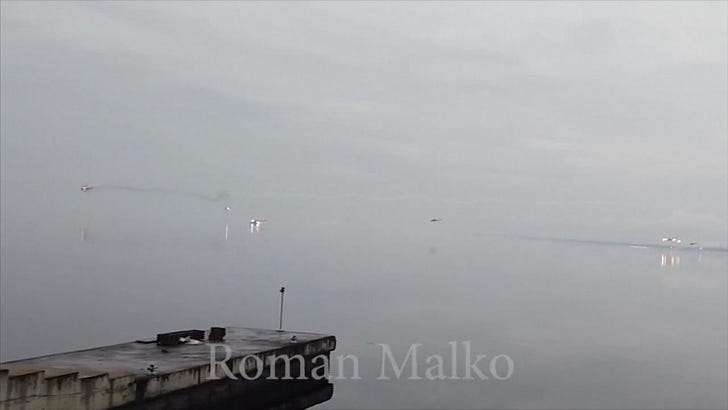


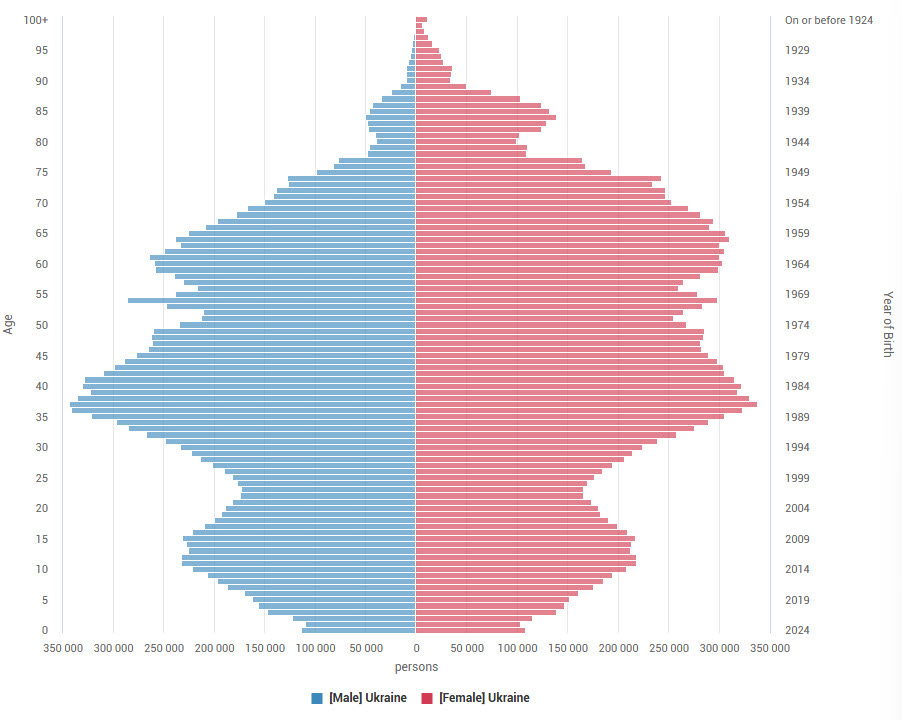
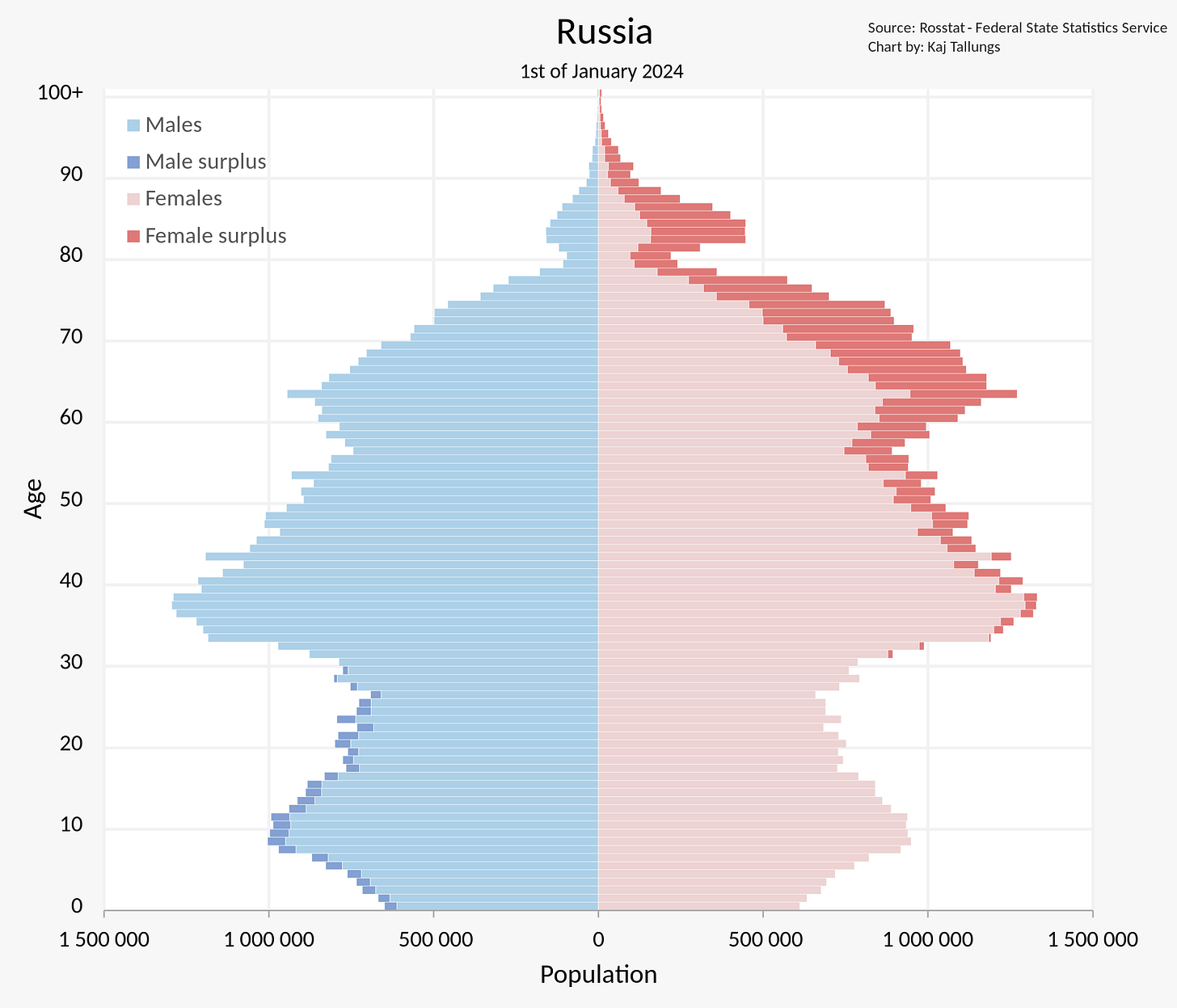
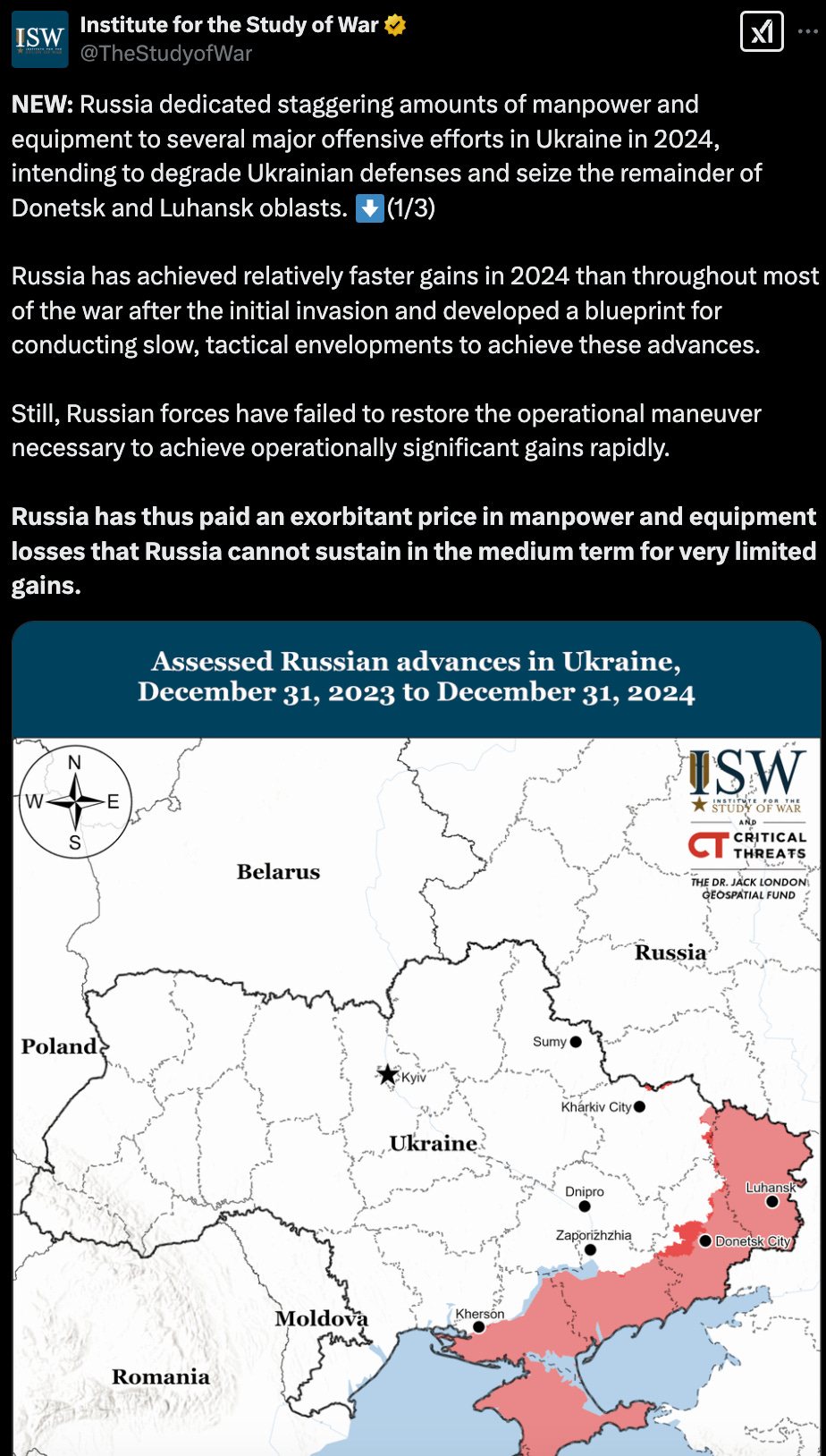
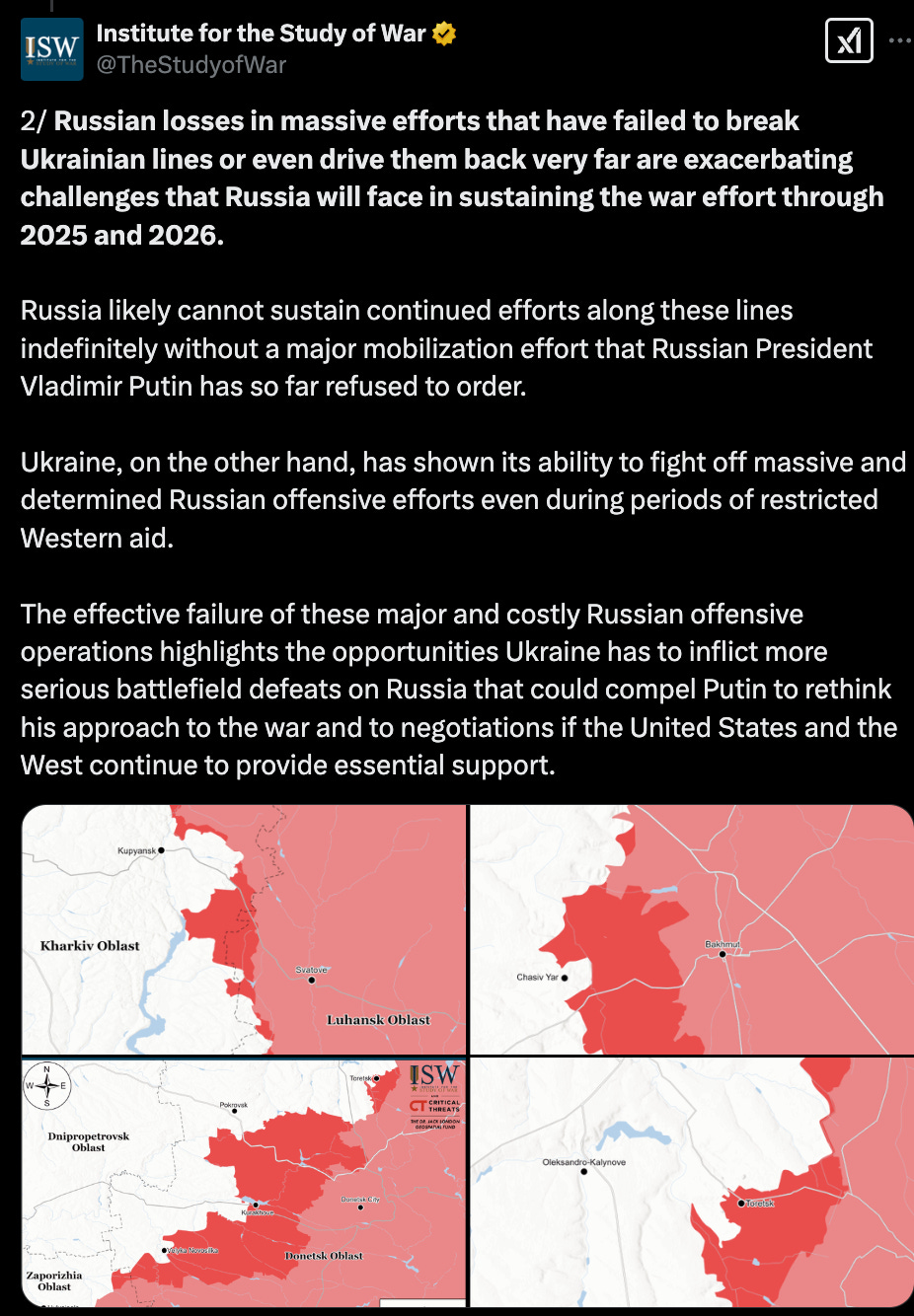
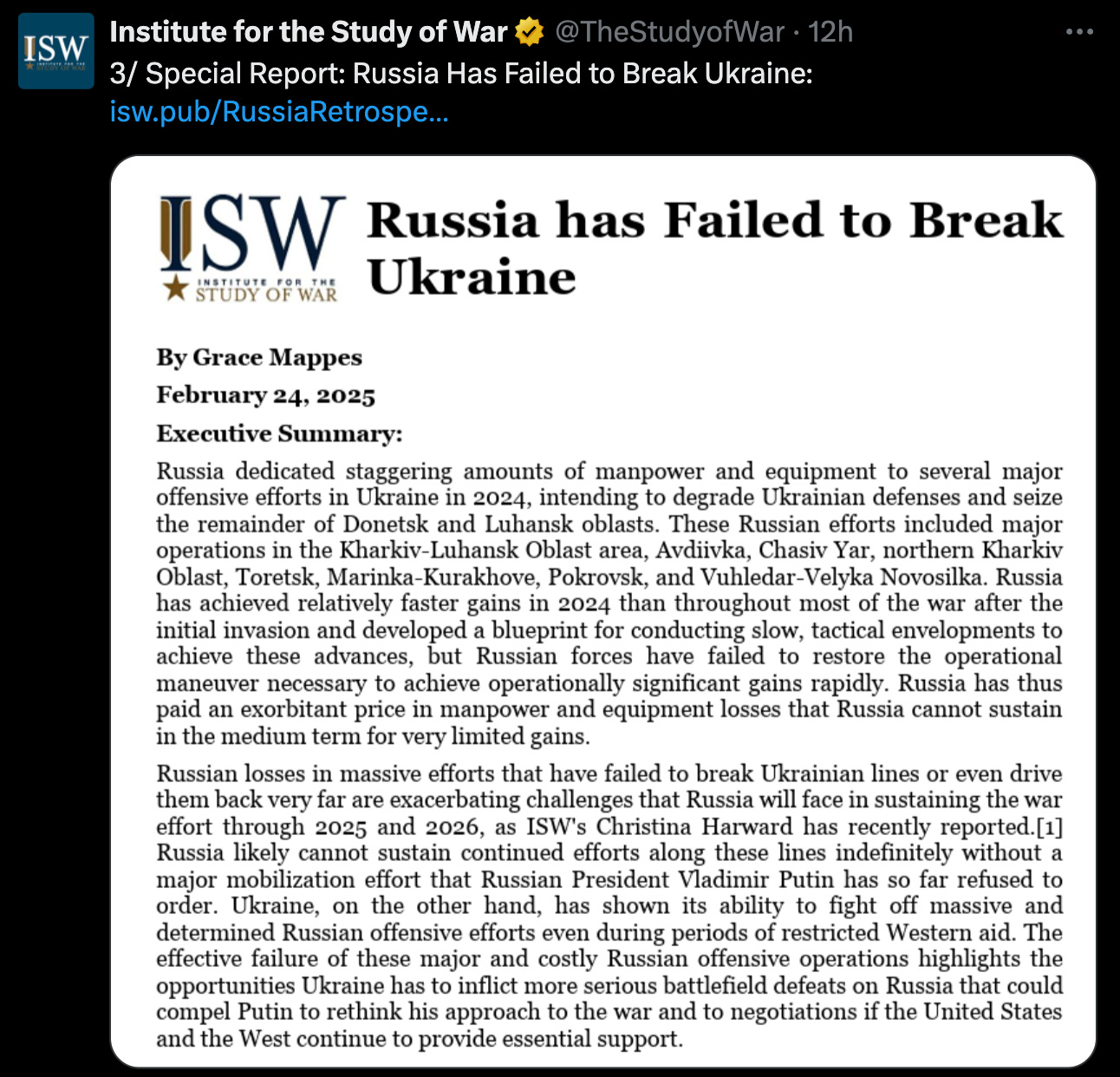
Excellent piece. Thank you for the comprehensive review and evaluation of the fighting parties (including demographics!), tiebacks to similar conflicts in history, and well-grounded possibilities and limitations that will likely shape the future of the conflict. The only thing missing, for obvious reasons, is the section on "Lessons Learned."
Just great Sal. Thank you.